|
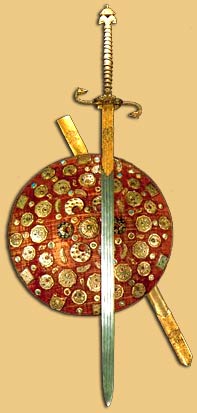 The
collection of state regalia (royal objects) in the Armoury Chamber
of Kremlin is the national pride of Russia. It consists of crowns,
scepters, thrones, the state sword and shield, chains and crosses
which played a leading part in court ceremonial from the thirteenth
to nineteenth century. The
collection of state regalia (royal objects) in the Armoury Chamber
of Kremlin is the national pride of Russia. It consists of crowns,
scepters, thrones, the state sword and shield, chains and crosses
which played a leading part in court ceremonial from the thirteenth
to nineteenth century.
These sacred relics, symbols of state power, were passed
down from generation to generation, affirming the continuity and
unshakeability of supreme autocracy. They reflect the whole history
of the Russian state and were witnesses of the most significant
political events.
All these items are of great artistic, historical and material
value. They were used almost without changes at all the coronations
right up to that of the coronation
of Nicholas II.
"The purpose of the coronation is
to establish bonds between the tsar's authority and that of the
Church. It is a meshing of church and state and names the tsar Father,
Head and Ruler of all Russian people by the will of God."
|
|
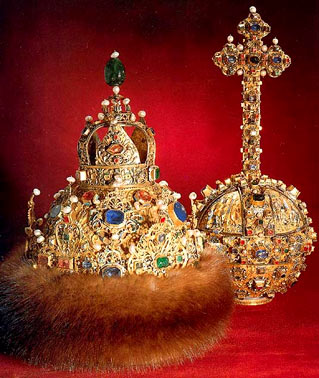
Crown and Orb from Tsar Micheal Romanov
late 16th century.
|
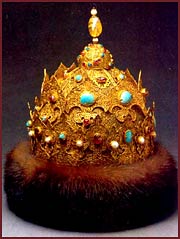 The
special importance of coronations dictated the need for the
symbols of power to be fashioned with the utmost richness. Many
of them have no equal in world collections in terms of their
beauty, fine execution and the rare precious stones that adorn
them. The
special importance of coronations dictated the need for the
symbols of power to be fashioned with the utmost richness. Many
of them have no equal in world collections in terms of their
beauty, fine execution and the rare precious stones that adorn
them.
|
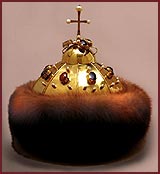 The
18th century celebrations after the coronation began to reflect
an increasing influence of other royal houses in Europe, most
notably that of Prussia. From the eighteenth century, the practice
of showering the tsar with gold and silver coins was discontinued.
During the entry procession to the Archangel and Annunciation
Cathedrals, gold and silver medals were thrown into the crowd.
In addition, courtiers were awarded medals specially minted
for the coronation. The
18th century celebrations after the coronation began to reflect
an increasing influence of other royal houses in Europe, most
notably that of Prussia. From the eighteenth century, the practice
of showering the tsar with gold and silver coins was discontinued.
During the entry procession to the Archangel and Annunciation
Cathedrals, gold and silver medals were thrown into the crowd.
In addition, courtiers were awarded medals specially minted
for the coronation.
|
 Throne of Ivan the Terrible.
Throne of Ivan the Terrible.
|
Across the country the people celebrated
the crowning of a new ruler in various ways. There were swains
and carousels, jugglers and acrobats, and many different kinds
of refreshments. Wheeled tables and platforms were set up on
the squares of the city and roast sheep and oxen, stuffed birds,
and pyramids of kalach, a traditional Russian loaf. Fountains
of wine poured forth, and barrels of beer and wine were driven
about the town. Commemorative gifts were also distributed among
the people.
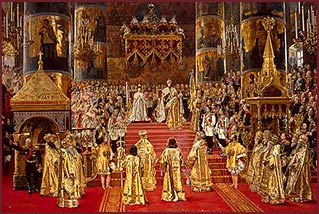 The Coronation of Empreror Alexander
III and Empress Maria Fyodorovna, G. Becker, Oil on canvas.
1888.
The Coronation of Empreror Alexander
III and Empress Maria Fyodorovna, G. Becker, Oil on canvas.
1888.
|
| For several weeks after the
coronation ceremony concluded, the rulers held audiences in
the royal palace where they received congratulations and hosted
banquets. Balls, masquerades, and theatrical presentations followed
one after the other. For a short time, lavish illumination and
fabulous fireworks turned the ancient capital into a fairytale
city. |

|
The Coronation
of Nicholas ll and Alexandra, 1896
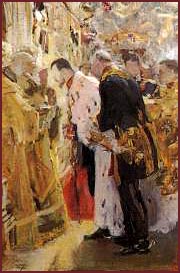 The
Coronation of Nicholas ll and Alexandra
took place in Moscow in 1896. The whole old-world pomp of the
Russian Court was displayed there. It was a glorious pageant
for the whole country, apart from the importance it had in the
eyes of those who saw in the religious rites the real consecration
of their sovereign. The
Coronation of Nicholas ll and Alexandra
took place in Moscow in 1896. The whole old-world pomp of the
Russian Court was displayed there. It was a glorious pageant
for the whole country, apart from the importance it had in the
eyes of those who saw in the religious rites the real consecration
of their sovereign.
Everything was done to foster this feeling in the people
who came to Moscow for the celebrations from every part of the
vast Russian Empire. |
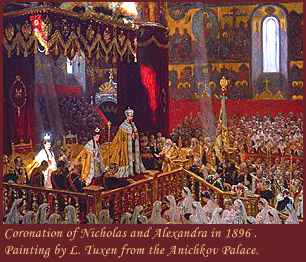
|
The Emperor granted amnesties
to prisoners, and bounties to all classes of his subjects: fines
were remitted, and facilities given for payment of taxes.
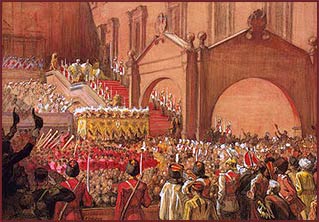
Nicholas II on the Red Porch after
his Coronation, A. Edelfelt. Watercolour and gouache. 1896.
|
|
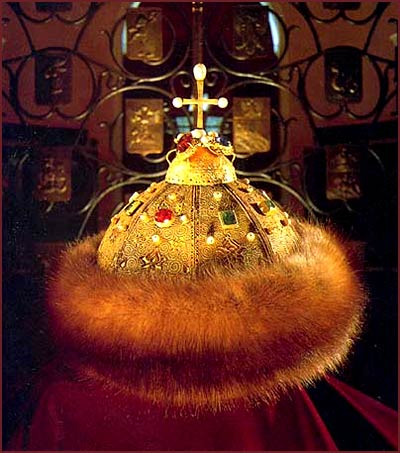
Crown of Tsar Momomach late 13th century.
|
|
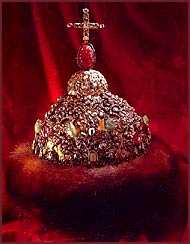 Even
though the Russian capital had been moved to St. Petersburg, the
tsars always returned to Moscow for the coronation in the Kremlin's
Dormition Cathedral. As the coronation
festivities approached, the whole court set off from St. Petersburg
to Moscow. According to custom, the royal family stopped in elaborate
village palaces to prepare for their royal entry into the ancient
capital. This entry into Moscow was greeted with a gun salute, the
ringing of bells from the Ivan the Great
Bell Tower in the Kremlin, and the sound of trumpets and kettledrums.
The arrival of the royal family was marked by a grand procession
(conducted according to a strictly defined order) including representatives
of all the peoples in the mighty Russian Empire. For coronation
ceremonies, triumphal gates were erected "with unparalleled
decoration." They were funded by the Church, Moscow merchants,
the municipal government, and other benefactors. Subjects bearing
gifts greeted the tsar at the gates, and choirs sang solemn hymns.
Priests with crosses and other holy artifacts came from the churches
of Moscow to greet the royal family. Even
though the Russian capital had been moved to St. Petersburg, the
tsars always returned to Moscow for the coronation in the Kremlin's
Dormition Cathedral. As the coronation
festivities approached, the whole court set off from St. Petersburg
to Moscow. According to custom, the royal family stopped in elaborate
village palaces to prepare for their royal entry into the ancient
capital. This entry into Moscow was greeted with a gun salute, the
ringing of bells from the Ivan the Great
Bell Tower in the Kremlin, and the sound of trumpets and kettledrums.
The arrival of the royal family was marked by a grand procession
(conducted according to a strictly defined order) including representatives
of all the peoples in the mighty Russian Empire. For coronation
ceremonies, triumphal gates were erected "with unparalleled
decoration." They were funded by the Church, Moscow merchants,
the municipal government, and other benefactors. Subjects bearing
gifts greeted the tsar at the gates, and choirs sang solemn hymns.
Priests with crosses and other holy artifacts came from the churches
of Moscow to greet the royal family.
|
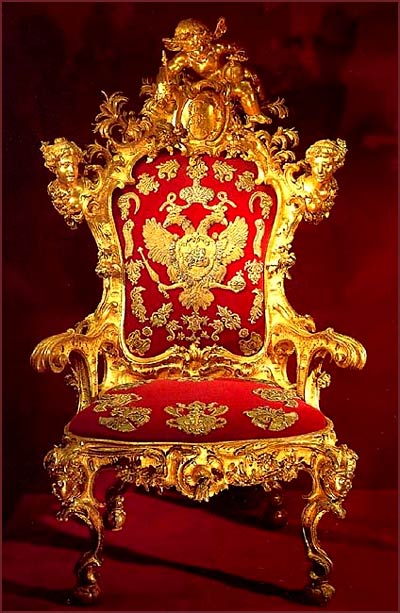
Throne of Tsarina Elizabeth, daugter of Peter
the Great, 1742.
|
 Regalia
that were used during these occasions included crowns, scepters, orbs,
swords, shields, seals, mantles, and banners. The ceremonial use of
these objects was key to the conferring of the royal power, and provided
a lasting tradition that was understood by all. The objects were ornate
often encrusted with diamonds, rubies, sapphires, pearls, and other
precious gems. These special royal objects inspired awe and respect,
and represented the wealth and power of the person possessing them.
Before the coronation, the regalia were brought from the Winter
Palace in St. Petersburg to the Moscow Armory, which, from the
beginning of the eighteenth century, served as a state treasury. On
the eve of the coronation, the regalia, along with other ancient ceremonial
articles, were carried to the Dormition
Cathedral. Regalia
that were used during these occasions included crowns, scepters, orbs,
swords, shields, seals, mantles, and banners. The ceremonial use of
these objects was key to the conferring of the royal power, and provided
a lasting tradition that was understood by all. The objects were ornate
often encrusted with diamonds, rubies, sapphires, pearls, and other
precious gems. These special royal objects inspired awe and respect,
and represented the wealth and power of the person possessing them.
Before the coronation, the regalia were brought from the Winter
Palace in St. Petersburg to the Moscow Armory, which, from the
beginning of the eighteenth century, served as a state treasury. On
the eve of the coronation, the regalia, along with other ancient ceremonial
articles, were carried to the Dormition
Cathedral.
|
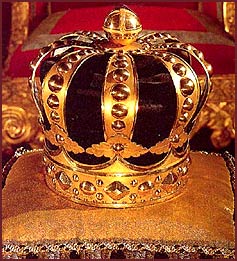 The
laying on of the regalia was accompanied by the recital of a prayer.
Here, too, Peter the Great made changes.
Peter the Great, who so fervently desired the growth and prosperity
of the Russian state, attempted to lend the coronation ceremony an
identifiable state character. The life giving cross was no longer
placed on the tsar; and the barmy, or ceremonial collar, also disappeared,
to be replaced by the new coronation mantle. The
laying on of the regalia was accompanied by the recital of a prayer.
Here, too, Peter the Great made changes.
Peter the Great, who so fervently desired the growth and prosperity
of the Russian state, attempted to lend the coronation ceremony an
identifiable state character. The life giving cross was no longer
placed on the tsar; and the barmy, or ceremonial collar, also disappeared,
to be replaced by the new coronation mantle.
|
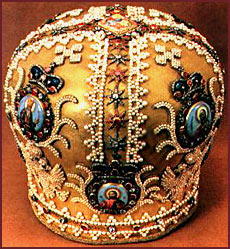 Likewise,
the ancient crown of the Russian tsars, the Cap of Monomach, was replaced
with a Western European style crown, made of two separate hemispheres
separated by an arc. At first, new crowns were usually made for each
coronation. In 1762, however, the famed St. Petersburg jeweler, Ieremiia
Poze, created a magnificent diamond crown for Catherine the Great.
This masterpiece of jeweler's art was used in all subsequent coronations
including that of the last member of the Romanov dynasty, Nicholas
II. Likewise,
the ancient crown of the Russian tsars, the Cap of Monomach, was replaced
with a Western European style crown, made of two separate hemispheres
separated by an arc. At first, new crowns were usually made for each
coronation. In 1762, however, the famed St. Petersburg jeweler, Ieremiia
Poze, created a magnificent diamond crown for Catherine the Great.
This masterpiece of jeweler's art was used in all subsequent coronations
including that of the last member of the Romanov dynasty, Nicholas
II.

|
ivan the terrible
| peter the great |
nicholas the second |
anastasia | imperial
style | regalia |
jewellery
|
|




 Regalia
that were used during these occasions included crowns, scepters, orbs,
swords, shields, seals, mantles, and banners. The ceremonial use of
these objects was key to the conferring of the royal power, and provided
a lasting tradition that was understood by all. The objects were ornate
often encrusted with diamonds, rubies, sapphires, pearls, and other
precious gems. These special royal objects inspired awe and respect,
and represented the wealth and power of the person possessing them.
Before the coronation, the regalia were brought from the Winter
Palace in St. Petersburg to the Moscow Armory, which, from the
beginning of the eighteenth century, served as a state treasury. On
the eve of the coronation, the regalia, along with other ancient ceremonial
articles, were carried to the Dormition
Cathedral.
Regalia
that were used during these occasions included crowns, scepters, orbs,
swords, shields, seals, mantles, and banners. The ceremonial use of
these objects was key to the conferring of the royal power, and provided
a lasting tradition that was understood by all. The objects were ornate
often encrusted with diamonds, rubies, sapphires, pearls, and other
precious gems. These special royal objects inspired awe and respect,
and represented the wealth and power of the person possessing them.
Before the coronation, the regalia were brought from the Winter
Palace in St. Petersburg to the Moscow Armory, which, from the
beginning of the eighteenth century, served as a state treasury. On
the eve of the coronation, the regalia, along with other ancient ceremonial
articles, were carried to the Dormition
Cathedral. The
laying on of the regalia was accompanied by the recital of a prayer.
Here, too, Peter the Great made changes.
Peter the Great, who so fervently desired the growth and prosperity
of the Russian state, attempted to lend the coronation ceremony an
identifiable state character. The life giving cross was no longer
placed on the tsar; and the barmy, or ceremonial collar, also disappeared,
to be replaced by the new coronation mantle.
The
laying on of the regalia was accompanied by the recital of a prayer.
Here, too, Peter the Great made changes.
Peter the Great, who so fervently desired the growth and prosperity
of the Russian state, attempted to lend the coronation ceremony an
identifiable state character. The life giving cross was no longer
placed on the tsar; and the barmy, or ceremonial collar, also disappeared,
to be replaced by the new coronation mantle.  Likewise,
the ancient crown of the Russian tsars, the Cap of Monomach, was replaced
with a Western European style crown, made of two separate hemispheres
separated by an arc. At first, new crowns were usually made for each
coronation. In 1762, however, the famed St. Petersburg jeweler, Ieremiia
Poze, created a magnificent diamond crown for Catherine the Great.
This masterpiece of jeweler's art was used in all subsequent coronations
including that of the last member of the Romanov dynasty, Nicholas
II.
Likewise,
the ancient crown of the Russian tsars, the Cap of Monomach, was replaced
with a Western European style crown, made of two separate hemispheres
separated by an arc. At first, new crowns were usually made for each
coronation. In 1762, however, the famed St. Petersburg jeweler, Ieremiia
Poze, created a magnificent diamond crown for Catherine the Great.
This masterpiece of jeweler's art was used in all subsequent coronations
including that of the last member of the Romanov dynasty, Nicholas
II.  The
collection of state regalia (royal objects) in the Armoury Chamber
of Kremlin is the national pride of Russia. It consists of crowns,
scepters, thrones, the state sword and shield, chains and crosses
which played a leading part in court ceremonial from the thirteenth
to nineteenth century.
The
collection of state regalia (royal objects) in the Armoury Chamber
of Kremlin is the national pride of Russia. It consists of crowns,
scepters, thrones, the state sword and shield, chains and crosses
which played a leading part in court ceremonial from the thirteenth
to nineteenth century. 
 The
special importance of coronations dictated the need for the
symbols of power to be fashioned with the utmost richness. Many
of them have no equal in world collections in terms of their
beauty, fine execution and the rare precious stones that adorn
them.
The
special importance of coronations dictated the need for the
symbols of power to be fashioned with the utmost richness. Many
of them have no equal in world collections in terms of their
beauty, fine execution and the rare precious stones that adorn
them.  The
18th century celebrations after the coronation began to reflect
an increasing influence of other royal houses in Europe, most
notably that of Prussia. From the eighteenth century, the practice
of showering the tsar with gold and silver coins was discontinued.
During the entry procession to the Archangel and Annunciation
Cathedrals, gold and silver medals were thrown into the crowd.
In addition, courtiers were awarded medals specially minted
for the coronation.
The
18th century celebrations after the coronation began to reflect
an increasing influence of other royal houses in Europe, most
notably that of Prussia. From the eighteenth century, the practice
of showering the tsar with gold and silver coins was discontinued.
During the entry procession to the Archangel and Annunciation
Cathedrals, gold and silver medals were thrown into the crowd.
In addition, courtiers were awarded medals specially minted
for the coronation.  Throne of Ivan the Terrible.
Throne of Ivan the Terrible.
 The Coronation of Empreror Alexander
III and Empress Maria Fyodorovna, G. Becker, Oil on canvas.
1888.
The Coronation of Empreror Alexander
III and Empress Maria Fyodorovna, G. Becker, Oil on canvas.
1888.  The
Coronation of
The
Coronation of 

 Even
though the Russian capital had been moved to St. Petersburg, the
tsars always returned to Moscow for the coronation in the Kremlin's
Even
though the Russian capital had been moved to St. Petersburg, the
tsars always returned to Moscow for the coronation in the Kremlin's